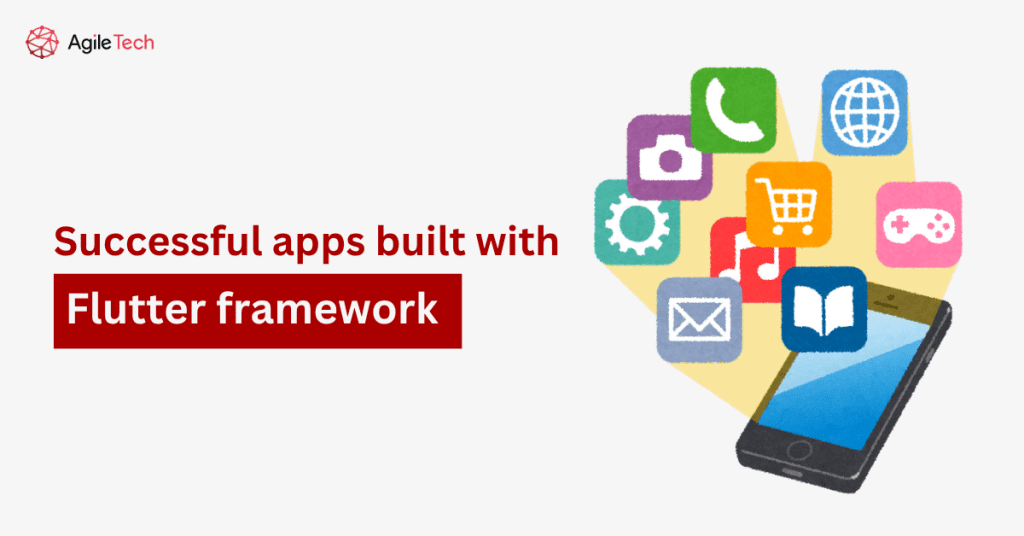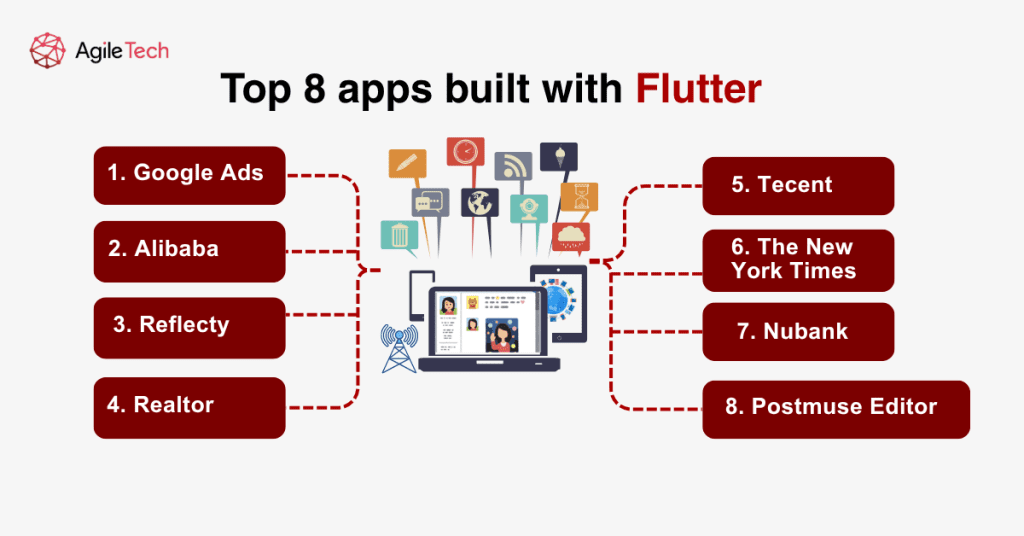8 Successful apps built with Flutter framework
In recent years, Flutter has become well-known as one of the best frameworks in the cross-platform world for mobile app development. Being the world’s most successful framework, Flutter has helped multiple brands to build modern, simple-to-use apps in a shorter period and a minimal budget. In this blog post, let’s discover some of the popular apps built with Flutter

1. What is Flutter?
Flutter is an open-source mobile application development framework created by Google. Launched in 2017, Flutter has quickly become one of the most popular cross-platform development tools available today. The standout feature of Flutter is its ability to build visually appealing, high-performance applications across multiple platforms from a single codebase.
Flutter uses the Dart programming language, also developed by Google, which helps developers create smooth applications with Material Design or Cupertino (iOS) styling. With its rich widget system and high customizability, Flutter delivers a flexible and efficient development experience.
The main advantages of Flutter include:
- Fast development with the Hot Reload feature
- Performance nearly equivalent to native applications
- Beautiful and consistent user interfaces across platforms
- Strong development community and support from Google
- Excellent scalability for large projects
With these advantages, it’s no surprise that many large companies have chosen Flutter for developing their applications. Let’s explore 8 successful apps built with Flutter.
2. 8 apps built with Flutter

There are many apps built with Flutter. Now, we’ll show you some of the most popular apps, so you can get a sense of what Flutter can do. Here are the 8 most popular Flutter app developments so far.
2.1. Google Ads
Google Ads is one of the first applications developed by Google using Flutter. As an advertising campaign management tool, this app requires a smooth user interface and the ability to process complex data.
With Flutter, Google created a mobile application that allows users to track and manage their advertising campaigns from anywhere. The app provides visual charts, real-time notifications, and the ability to quickly adjust advertising budgets.
Google’s use of Flutter for its application demonstrates its confidence in this technology and serves as proof of Flutter’s capability in building complex enterprise applications.
2.2. Alibaba
Alibaba, the Chinese e-commerce giant, chose Flutter to develop certain features in their Xianyu app – a second-hand goods trading platform with over 50 million users.
Alibaba’s development team highly appreciated Flutter’s ability to create smooth and consistent user interfaces. The adoption of Flutter helped them increase development efficiency and significantly improve the user experience.
According to Alibaba’s engineers, Flutter helped them reduce development and maintenance time while creating beautiful user interfaces with high performance. This is a classic example showing that Flutter can handle large-scale applications with millions of users.
2.3. Reflectly
Reflectly is a smart journal app that uses artificial intelligence to help users improve their mental health. It’s one of Flutter’s standout successes in the startup application space.
Initially developed only for iOS using Swift, the Reflectly development team decided to switch to Flutter to expand to the Android platform. Thanks to Flutter, they were able to maintain a single codebase for both platforms, significantly reducing development and maintenance costs.
Reflectly is known for its beautiful user interface, smooth animations, and seamless user experience – all implemented through Flutter. The app has achieved over 1 million downloads and received many positive reviews, proving that Flutter is an excellent choice for applications requiring premium user experiences.
Read more: Complete Development Roadmap to Build a Successful Fitness Tracker App
2.4. Realtor
Realtor.com, one of the largest real estate platforms in the US, used Flutter to build its mobile application. With millions of real estate listings and a large user base, Realtor needed an app capable of handling complex data and displaying rich content.
Flutter helped Realtor create an application with fast search capabilities, interactive maps, and smooth photo browsers. Users can easily search, filter, and save their favorite real estate listings.
Realtor’s development team highly valued Flutter’s Hot Reload feature, allowing them to make changes and improvements quickly. The result is a high-performance application that meets the needs of both buyers and sellers in the real estate market.
2.5. Tencent
Tencent, the Chinese technology giant, has adopted Flutter in several of their projects, including the NOW Live app – a popular live streaming platform.
With millions of simultaneous users and high-performance requirements, Tencent’s choice of Flutter is a testament to the framework’s ability to handle heavy loads. The NOW Live app provides a smooth video viewing experience, real-time interaction, and an attractive user interface.
According to Tencent engineers, Flutter helps them optimize the development process and ensure a consistent experience across different devices. This is especially important in the Chinese market, where there is great diversity in Android devices.
2.6. The New York Times
The New York Times used Flutter to develop their KENKEN app – a popular logic puzzle game. This is an interesting example of using Flutter to create a highly interactive entertainment application.
KENKEN requires a responsive user interface and smooth animations while needing to work efficiently across various devices. Flutter has excellently met these requirements.
The New York Times development team shared that Flutter helped them create a consistent and engaging gaming experience on both iOS and Android, while significantly reducing development time compared to developing separately for each platform.
2.7. Nubank
Nubank, the world’s largest digital bank and a leading fintech company in Latin America, used Flutter to develop their mobile application. With over 40 million customers, Nubank needed a secure, high-performance, and user-friendly application.
Flutter helped Nubank create a banking application with a modern interface, fast response time, and excellent user experience. This app allows users to manage accounts, perform transactions, and access financial services easily.
The fact that a large financial institution like Nubank chose Flutter shows that this framework is not only suitable for entertainment applications but can also meet the strict security and performance requirements in the financial sector.
Read more: How to build a Mobile Banking App: Comprehensive Guide
2.8. PostMuse Editor
PostMuse is a photo editing and content design application for Instagram, developed entirely with Flutter. This app provides professional design tools, templates, and effects to create engaging content for social media.
With Flutter, PostMuse developers created a powerful photo editor with an intuitive user interface and many advanced features. Flutter’s smooth image processing and high performance have helped PostMuse become one of the highest-rated photo editing apps on both the App Store and Google Play.
PostMuse is an excellent example of how Flutter can be used to build complex graphic processing applications with outstanding user experiences.
Conclusion
Flutter has proven to be a powerful and versatile framework for cross-platform application development. Through the 8 successful examples above, we can see that Flutter is suitable for many different types of applications, from e-commerce, finance, and entertainment to creative tools.
These applications not only demonstrate Flutter’s technical capabilities but also show the business advantages of using this framework: reduced development time, maintenance cost savings, and providing a consistent user experience across platforms.
With continuous development and strong support from Google and the large community, Flutter will certainly continue to be a top choice for companies wanting to develop high-quality mobile applications in the future.
